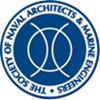Spray Formation and Structural Deformation During the Oblique Impact of a Flexible Plate on a Quiescent Water Surface
IF 1
4区 工程技术
Q3 ENGINEERING, CIVIL
引用次数: 4
Abstract
The oblique impact of a flexible and a nearly rigid plate on a quiescent water surface is studied experimentally. Both plates are 122 cm long by 38 cm wide and are mounted with a 5° upward pitch angle and a 10° lateral roll angle. The plates are attached to a dual-axis instrument carriage. The horizontal and vertical components of the carriage (plate) motion are driven by servo motors and controlled by a single computer-based feedback system, which is set with a single trajectory that is traversed for all impact speeds. The transient strain at multiple locations on the upper surface of the plate is measured with optical fiber Bragg grating sensors and the out-of-plane deformation is measured with a photographic method. A cinematic laser-induced fluorescence technique is used to measure the water spray generated during the impact. Two types of spray are observed and several aspects of the spray behavior are found to be noticeably affected by the deformation of the plate. The maximum deflection along the plate's upper long edge is found to increase almost linearly with impact velocity. In rough seas, planing boats moving at high speed frequently slam into the water surface. The slamming process involves large highly transient pressures and forces on the hull, rapid accelerations of the boat and the water, the generation of water spray, and significant structural responses. This phenomenon is difficult to study numerically and experimentally because of the large motions of the hull and the violent motions of the water free surface, including the formation of spray sheets and the structural responses coupled with the flow dynamics. The problem of slamming (water entry) has received significant attention in the past. Many of the previous studies on this subject examine fundamental problems, such as the impact of a wedge or a flat plate on water surface. Some early theoretical studies on the water entry of a rigid wedge include, e.g., Von Karman (1929) and Wagner (1932). Wagner's model considers the water rising adjacent to the surface of a vertically moving wedge with small deadrise angle. This model was later extended to higher order (e.g., Oliver 2007) and other geometries (e.g., Howison et al. 1991). Based on Wagner's theory, Dobrovol'Skaya (1969) derived a similarity solution to the water entry of a wedge and the solution at small deadrise angles (down to 4°) was computed numerically by Zhao and Faltinsen (1993) using a nonlinear boundary element method. De Divitiis and de Socio (2002) studied the water entry of symmetric and asymmetric wedges. In their method, the flow field is represented by potential flow singularities whose intensities are determined as part of the solution. Moore et al. (2012) did a numerical study of normal and oblique water entry of a threedimensional rigid body with its bottom surface nearly parallel to the water surface.柔性板在静止水面上斜冲击时的喷雾形成和结构变形
实验研究了柔性板和近似刚性板在静止水面上的倾斜冲击。两块板长122厘米,宽38厘米,安装时上倾角为5°,横向倾角为10°。这些板连接到双轴仪器支架上。滑架(板)运动的水平和垂直分量由伺服电机驱动,并由单个基于计算机的反馈系统控制,该系统设置有针对所有冲击速度的单个轨迹。用光纤布拉格光栅传感器测量了板上表面多个位置的瞬态应变,并用照相法测量了平面外变形。电影激光诱导荧光技术用于测量撞击过程中产生的水雾。观察到两种类型的喷雾,发现喷雾行为的几个方面明显受到板变形的影响。发现沿板上部长边的最大挠度几乎随冲击速度线性增加。在波涛汹涌的海面上,高速行驶的滑行艇经常撞向水面。砰击过程涉及船体上巨大的高度瞬态压力和力、船和水的快速加速、喷水的产生以及显著的结构响应。这种现象很难在数值和实验上进行研究,因为船体的大运动和无水表面的剧烈运动,包括喷射片的形成和与流动动力学相结合的结构响应。砰击(进水)问题在过去受到了极大的关注。以前关于这一主题的许多研究都探讨了一些基本问题,例如楔形物或平板对水面的影响。一些早期关于刚性楔入水的理论研究包括Von Karman(1929)和Wagner(1932)。Wagner的模型考虑了在具有小上升角的垂直移动楔表面附近上升的水。该模型后来被扩展到更高阶(例如,Oliver 2007)和其他几何形状(例如,Howison等人1991)。根据Wagner的理论,Dobrovol’Skaya(1969)导出了楔形入水的相似解,赵和Faltinsen(1993)使用非线性边界元方法对小静上升角(低至4°)的解进行了数值计算。De Divitiis和De Social(2002)研究了对称和不对称楔形的入水情况。在他们的方法中,流场由势流奇点表示,势流奇点的强度是作为解的一部分确定的。Moore等人(2012)对底部表面几乎平行于水面的三维刚体的正常和倾斜进水进行了数值研究。
本文章由计算机程序翻译,如有差异,请以英文原文为准。
求助全文
约1分钟内获得全文
求助全文
来源期刊

Journal of Ship Research
工程技术-工程:海洋
CiteScore
2.80
自引率
0.00%
发文量
12
审稿时长
6 months
期刊介绍:
Original and Timely technical papers addressing problems of shipyard techniques and production of merchant and naval ships appear in this quarterly publication. Since its inception, the Journal of Ship Production and Design (formerly the Journal of Ship Production) has been a forum for peer-reviewed, professionally edited papers from academic and industry sources. As such, it has influenced the worldwide development of ship production engineering as a fully qualified professional discipline. The expanded scope seeks papers in additional areas, specifically ship design, including design for production, plus other marine technology topics, such as ship operations, shipping economic, and safety. Each issue contains a well-rounded selection of technical papers relevant to marine professionals.
 求助内容:
求助内容: 应助结果提醒方式:
应助结果提醒方式:


